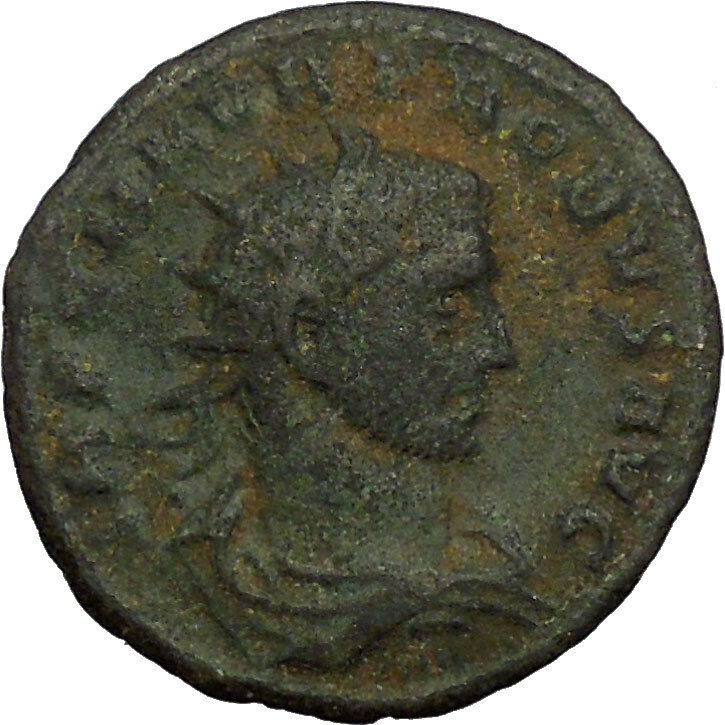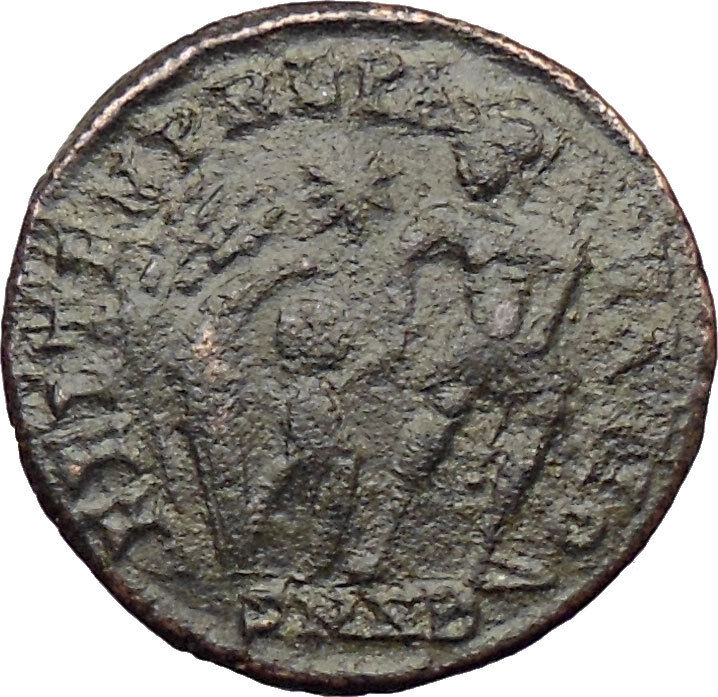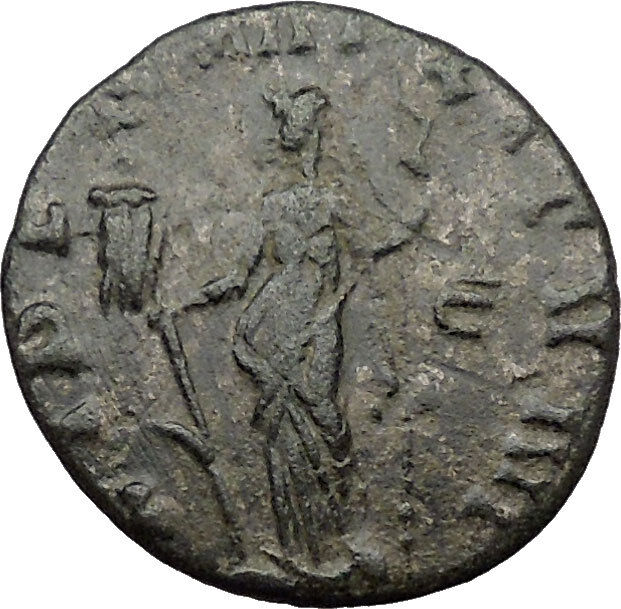|
<=”” font=”” color=”#000000″ face=”Times New Roman”>
Quintillus
–
Roman Emperor
: 270 A.D. –
Bronze Antoninianus 18mm (1.67 grams) Rome mint: 270 A.D.
Reference: RIC 13a, Giard 10052
IMPCMAVRCLQVINTILLVSAVG – Radiate, draped bust right.
CONCORDIAAVG – Concordia standing left, sacrificing over altar and holding
double cornucopia.
You are bidding on the exact item pictured,
provided with a Certificate of Authenticity and Lifetime Guarantee of
Authenticity.
In
ancient Roman religion
, Concordia is the
goddess
who embodies agreement in marriage and
society. Her
Greek equivalent
is usually regarded as
Harmonia
, with
musical harmony
a
metaphor
for an ideal of social concord or
entente
in the political
discourse
of the
Republican era
. She was thus often associated
with
Pax
(“Peace”) in representing a stable
society.As such, she is more closely related to the Greek concept of
homonoia
(likemindedness),
which was also represented by
a goddess
.

Concordia, standing with a
patera
and two
cornucopiae
, on the reverse of this
coin of
Aquilia Severa
..
Concordia
Augusta
was
cultivated
in the context of
Imperial cult
. Dedicatory inscriptions to her,
on behalf of emperors and members of the imperial family, were common.
In art
patera (sacrificial bowl), a
cornucopia
(symbol of prosperity), or a
caduceus
(symbol of peace). She was often shown
in between two other figures, such as standing between two members of the
Imperial family shaking hands. She was associated with a pair of female deities,
such as
Pax
and
Salus
, or
Securitas
and
Fortuna
. Paired “Security and Luck” could also
be represented by
Hercules
and
Mercury
.
Temples
The oldest
Temple of Concord
, built in 367 BC by
Marcus Furius Camillus
, stood on the
Roman Forum
. Other temples and shrines in Rome
dedicated to Concordia were largely geographically related to the main temple,
and included (in date order):
- a bronze shrine (aedicula) of Concord erected by the
aedile
Gnaeus Flavius
in 304 BC “in
Graecostasis
” and “in area Volcani”
(placing it on the Graecostasis, close to the main temple of Concord). He
vowed it in the hope of reconciling the nobility who had been outraged by
his publication of the calendar, but the senate would vote no money for its
construction and this thus had to be financed out of the fines of condemned
usurers.[5]
It must have been destroyed when the main temple was enlarged by Opimius in
121 BC.
- one built on the
arx
(probably on the east side, overlooked
the main temple of Concord below). It was probably vowed by the
praetor
Lucius Manlius
in 218 BC after quelling a
mutiny among his troops in
Cisalpine Gaul
,[6]
with building work commencing in 217 and dedication occurring on 5 February
216.
- a temple to Concordia Nova, marking the end
Julius Caesar
had brought to civil war. It
was voted by the senate in 44 BC.[8]
but was possibly never built.
Livia according to Ovid’s
Fasti
VI.637‑638 (“te quoque magnifica,
Concordia, dedicat
aede
Livia quam caro praestitit ipsa viro”
– the only literary reference to this temple). The description of the
Porticus Liviae
follows immediately, and it
is probable therefore that the temple was close to or within the porticus,
but the small rectangular structure marked on the Marble Plan (frg. 10) can
hardly have been a temple deserving of the epithet “magnifica” (HJ 316).
In Pompeii
, the high priestess
Eumachia
dedicated a building to Concordia
Augusta.
Modern religion
Harmonians and some
Discordians
equate Concordia with
Aneris
. Her opposite is thus Discordia, or the
Greek
Eris
is a symbol of abundance and nourishment, commonly a large horn-shaped container
overflowing with produce, flowers, nuts, other edibles, or wealth in some form.
Originating in
horn of plenty) or cornu copiae (from Latin cornucopiaaThe classical antiquity
, it has continued as a
symbol in
Western art
, and it is particularly associated
with the
Thanksgiving
holiday in
North America
.

Allegorical
depiction of the Roman
goddess
Abundantia
with a cornucopia, by
Rubens
(ca. 1630)
In Mythology
Mythology
offers multiple
explanations of the origin
of the cornucopia.
One of the best-known involves the birth and nurturance of the infant
Zeus, who had to be hidden from his devouring father
Cronus
. In a cave on
Mount Ida
on the island of
Crete
, baby Zeus was cared for and protected by
a number of divine attendants, including the goat
Amalthea
(“Nourishing Goddess”), who fed him
with her milk. The suckling future king of the gods had unusual abilities and
strength, and in playing with his nursemaid accidentally broke off one of her
horns
, which then had the divine power to
provide unending nourishment, as the foster mother had to the god.
In another myth, the cornucopia was created when
Heracles
(Roman
Hercules
) wrestled with the river god
Achelous
and wrenched off one of his horns;
river gods were sometimes depicted as horned. This version is represented in the
Achelous and Hercules
mural painting
by the
American Regionalist
artist
Thomas Hart Benton
.
The cornucopia became the attribute of several
Greek
and
Roman deities
, particularly those associated
with the harvest, prosperity, or spiritual abundance, such as personifications
of Earth (Gaia
or
Terra
); the child
Plutus
, god of riches and son of the grain
goddess Demeter
; the
nymph
Maia
; and
Fortuna
, the goddess of luck, who had the power
to grant prosperity. In
Roman Imperial cult
, abstract Roman deities who
fostered peace (pax
Romana) and prosperity were also depicted with a cornucopia,
including Abundantia
, “Abundance” personified, and
Annona
, goddess of the
grain supply to the city of Rome
.
Pluto
, the classical ruler of the underworld in
the
mystery religions
, was a giver of agricultural,
mineral and spiritual wealth, and in art often holds a cornucopia to distinguish
him from the gloomier Hades
, who holds a
drinking horn
instead.
Modern depictions
In modern depictions, the cornucopia is typically a hollow, horn-shaped
wicker basket filled with various kinds of festive
fruit
and
vegetables
. In North America, the cornucopia
has come to be associated with
Thanksgiving
and the harvest. Cornucopia is
also the name of the annual November Wine and Food celebration in
Whistler
, British Columbia, Canada. Two
cornucopias are seen in the
flag
and
state seal
of
Idaho
. The Great
Seal
of
North Carolina
depicts Liberty standing and
Plenty holding a cornucopia. The coat of arms of
Colombia
,
Panama
,
Peru and
Venezuela
, and the Coat of Arms of the State of
Victoria, Australia
, also feature the
cornucopia, symbolising prosperity.
The horn of plenty is used on body art and at Halloween, as it is a symbol of
fertility, fortune and abundance.
-
Base of a statue of
Louis XV of France
Marcus Aurelius Claudius Quintillus (ca 220 – April 270) was born
in Sirmium
(now
Sremska Mitrovica
,
Serbia
)in
Illyricum
.
He was brother of
Roman
Emperor
Claudius II
, and became
Emperor
himself in 270. Quintillus’ origin is uncertain. He was either from
Sirmium
(Syrmia;
in Pannonia
Inferior) or from Naissus
Dardania
(in
Moesia Superior
); both areas are located in
Serbia
. His
parents were Flavius Numerius and wife Claudia (b. ca 190), and his brothers
were Flavius Crispius (b. ca 210), married to Aurelia Pompeiana (b. ca 210) with
whom he had children, and
Claudius II
. His maternal grandparents were
Claudius Apellinus
,
Governor
of
Britannia Inferior
, and wife Bassina (b. ca 170).
Historia Augusta
reports that he became Emperor in a
coup
d’état
. Eutropius
reports Quintillus to have been elected by
soldiers
of
the Roman
army
immediately following the death of his brother. The choice was
reportedly approved by the
Roman
Senate
.
Joannes Zonaras
however reports him elected by the Senate itself.
Records however agree that the
legions
which had followed Claudius in campaigning along the
Danube
were
either unaware or disapproving of Quintillus’ elevation. They instead elevated
their current leader
Aurelian
to
the rank of Augustus
. Historia Augusta reports Aurelian to have been chosen by
Claudius himself as a successor, apparently in a deathbed decision.
Reign of Quintillus
The few records of Quintillus’ reign are contradictory. They disagree on the
length of his reign, variously reported to have lasted as few as 17 days and as
many as 177 days (about six months). He was a
Consul
in 270, for 77 days. Records also disagree on the cause of his death.
Historia Augusta reports him
murdered
by his
own soldiers in reaction to his strict
military discipline
.
Jerome
reports
him killed, presumably in conflict with Aurelian.
John of Antioch
and Joannes Zonaras reported Quintillus to have committed
suicide
by
opening his veins
and bleeding himself to death. John reports the suicide to have been assisted by
a physician
.
Claudius Salmasius
pointed that
Dexippus
recorded the death without stating causes. All records however agree in placing
the death at Aquileia
.
Quintillus was reportedly survived by his two sons.
Historia Augusta reports Claudius and Quintillus having another
brother named Crispus and through him a niece, Claudia. who reportedly married
Eutropius and was mother to
Constantius Chlorus
. Historians however suspect this account to be a
genealogical
fabrication
to flatter
Constantine I
.
Surviving Roman records considered Quintillus a moderate and capable Emperor.
He was seen as a champion of the Senate and thus compared to previous Emperors
Servius Sulpicius Galba
and
Publius Helvius Pertinax
. All three were highly regarded by Senatorial
sources despite their failure to survive a full year of reign.
|












